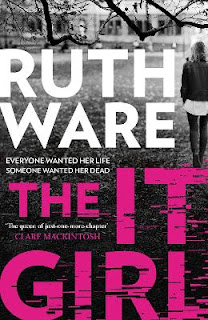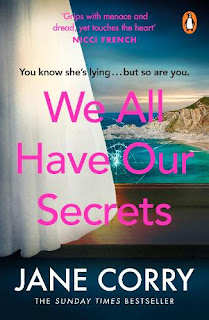Meet Jane Shemilt Author Of The Patient.
Jane Shemilt's, who herself is a doctor turned writer, novel The Patient is out now. A tale of medicine, obsession and what could happen if you follow your desires, it's Jane's fifth book, following in the footsteps of her best-selling novel The Daughter.
In our exclusive interview Jane discusses whether characters need to be likeable; her writing process; reveals her top tips for thriller writing; and what her favourite tipple is at the end of the day.
You can download the ebook of The Patient from Amazon or buy the paperback from Thriller Women's list at Bookshop.org. NB: if you buy books through this link we may earn a commission from bookshop.org, whose fees support independent bookshops.
TW: How does it feel to be publishing book five? Has working as an author been everything you expected, following the inclusion of your first book Daughter in Richard and Judy’s Book club in autumn 2014?
Working as an author is great but undeniably hard work. As the novels have progressed there is more of a sense that this is a job, something that doesn’t depend solely on inspiration. Inspiration matters of course, but so does craft, discipline and showing up, being fit mentally and physically. It’s tough grinding out words initially although that feeling of magic when the storycomes together on the re-write makes it all worthwhile.
TW: Tell us more about how you came up with the characters of Rachel and Luc in The Patient and how the story evolved.
JS: Luc has been in my mind for years; ever since as medical student I met a young lad who came into casualty in the grip of a full-blown manic episode. He was talking nonstop and pacing restlessly, his eyes glittering as he told me that he felt like a plane running down the runway, faster and faster about to take off. I knew exactly what he meant because I’d felt the same. As a sleep deprived medical student, I’d felt the edges of mania; chronic lack of sleep is known to do this. Of course, I can't pretend to have suffered anything like the horror of psychosis but all the same I felt kinship. Stigma against serious mental illness is growing and writing The Patient felt like a chance to show how someone suffering these kinds of disorders can be, of course, as attractive, desirable and as deserving of love as anyone else. People are always far more than their illnesses.
Rachel’s character and her desires grew from the experiences of friends, how women reported their lives at 49 and indeed from my experience. This is a time one is settled into a routine with an established career, a busy husband and a gap left by children who have left home. Space opens up. It'ss a time of second chances or maybe last ones. It's not too late, a voice whispers, to make good on those dreams of long ago. It was intriguing to play with the notion of what if? What if boundaries were broken and the law-abiding, settled married GP followed her heart?
TW: Relationships are an integral part of your novels. What is it that draws you to write about close family ties?
JS: Family relationships are the closest we have, in many ways the most powerful. In revealing family relationships in a novel, I hope that the closeness and trickiness will resonate with readers who will all be or will have been, part of a family. Families have secrets, it is almost inevitable. I love playing with that, presenting a family as ‘normal,’ happy and functioning, apparently calm, like the smooth surface of a still lake. As the novel progresses, I find ways to reveal the dark shadows underneath the surface, the
hidden currents that can become deadly.
Romantic relationships are another hook. I realised when I read or watch a film, however literary the book, however fascinating the setting, characters, themes or plot, I find myself rooting for the relationships: The English Patient by Michael Ondaatje, Jane Eye, Gone with the Wind or Gone Girl - I want to know at a simple, almost primitive level whether the couples get together. The success of the human race is predicated on couples getting together, perhaps our fascination with relationships is in encoded in our DNA.
TW: How much of the novel’s plot must you have worked out in advance before writing in earnest? Do you need to have worked out an ending?
JS: My plots are like those ordnance survey maps you take with you when you go for a country walk, useful to have as a guide to keep you going in the right direction with the end point in mind, but (with the map still in hand) you can venture off-piste to explore that shadowy wood under the hill over there, pick a few flower from the meadow you are passing, or maybe, if you dare, have a dip in the dark waters of the lake that glints so seductively from half way up that mountain.
When I begin to work out a plot, I mind-map on the page then write the first five chapters to feel my way in. After that comes the chapter headings which I jot down in a numbered list knowing that, as above, I can always deviate from the path.
TW: Some reviewers have argued that Rachel as a GP is not very likeable. Would you agree? Is it important that a lead character is likable in a story?
JS: The answer to the likeability question depends on your definition of likeable and whether it’s a useful characterisation. There is much to admire in Rachel. She is moral, caring and dedicated. She is a professional woman doing her job, she gives her patients time and attention, in fact she frequently over runs. She misses the suicidal depression in a young lad who doesn’t talk to her, beyond telling her he had a problem, but that doesn’t make her unlikeable, it makes her human and the haunting legacy of that incident echoes in her mind throughout the book.
Like everyone, Rachel is made up of multiple different strands: she is the ethical doctor who cares deeply about her patients and is haunted by her mistakes. She is also a wife who has stood loyally by her husband’s side for many years and a mother who did her best to bring up her daughter up alongside her career while, like so many of us, never quite getting it quite right. She is unequivocally a good neighbour both to the elderly couple who live in the house to one side, and to her best friend Victoria who lives in the house on the other side. And then there is the subconsciously wild Rachel, the part that was forged in childhood when she envied the little girl who was lost in the waters of a weir. Even then Rachel
recognised a longing to be swept away by something stronger than herself. That is the Rachel who decides against all reason and practicalities to visit a patient she is attracted to in his Provencal home.
TW: On a typical writing day, how much do you write and how long does it usually take to produce a first draft?
TW: On a typical writing day, how much do you write and how long does it usually take to produce a first draft?
JS: How much I write on a typical writing day depends on where I am in the evolution of the
narrative. I work for a minimum of three hours a day, forcing myself to produce words on the page however badly written.
Once I sat at my desk, checking the manuscript for 72 hours. It was magical, exhilarating and crazy. With everything smoothed out I was able to see connections between parts of the book that I hadn’t seen before, realising that something that happened on, say, page 20 echoed forward to page 120. It's the phase where I make sure to leave breadcrumbs for the reader so, although they don’t give the plot away, when readers do understand where the story is going, they can look back and say ‘Of course! I see now why that was mentioned in passing in Chapter Three, it all makes sense now…’
TW: What are you working on now?
JS:I have just completed the first draft of book 6 called The Therapist and sent that in about a month before The Patient was published, so soon I'll be working on it again, with input from my editors. It opens on the island of Paxos and has been described by the publishers as a gripping suspense novel in which the devastating consequences of an incident perpetrated by the drunk guests of a wealthy English holiday homeowner play out in a twisty story of revenge and hubris that spans 20 years.
TW: Sounds fabulous! What books do you read for pleasure. Any recommendations?
JS: This year, reading highlights include The Lamplighters by Emma Stonex; The High House by Jessie Greengrass; Sorrow and Bliss by Meg Mason; Girl A by Abigail Dean; Assembly by Natasha Brown and Luster by Raven Lelani.
All-time favourites that I return to include Commonwealth byAnn Patchett; Hamnet by Maggie O’Farrell; A Thousand Acres by Jane Smiley; and Wolf Hall and Bringing up the Bodies by Hilary Mantel.
TW: What advice would you give anyone looking to write a literary thriller?
JS: Read as widely as possible within and outside the genre. Watch the good ones on TV (e.g., The Killing). Go to as many plays as possible and study the characterisation.
The plot is most convincing if it grows from character; what they need and what they are
likely to do in order to secure it, what they might do if thwarted. Characters need to make consistent sense, and this is very often done on the re-writing. Twists must grow from the story, ideally be subtly signalled from early on.
Quick fire questions:
TW: Favourite novel from the last year?
TW: Favourite novel from the last year?
JS: Sorrow and Bliss by Meg Mason.
TW: Favourite all time book?
JS: Jane Eyre by Charlotte Bronte.
TW: Favourite holiday destination?
JS: Italy.
TW: Favourite series on television?
JS: Succession.
TW: Favourite tipple?
JS: Ginger beer with a sliver of lime and clinking with ice.
Thanks Jane!
More about The Patient:
When Rachel, a GP in Salisbury, meets Luc, the attraction between them is instant. But Rachel is married with a daughter - and Luc isn't well.
Despite themselves, a heady love affair begins - one that threatens to risk everything Rachel has worked for. And when someone in the town is found dead, the spotlight turns to Luc. Torn between her career, her marriage and her heart, Rachel finds herself in the middle of something much darker than she could have imagined...
When Rachel, a GP in Salisbury, meets Luc, the attraction between them is instant. But Rachel is married with a daughter - and Luc isn't well.
Despite themselves, a heady love affair begins - one that threatens to risk everything Rachel has worked for. And when someone in the town is found dead, the spotlight turns to Luc. Torn between her career, her marriage and her heart, Rachel finds herself in the middle of something much darker than she could have imagined...




Comments
Post a Comment